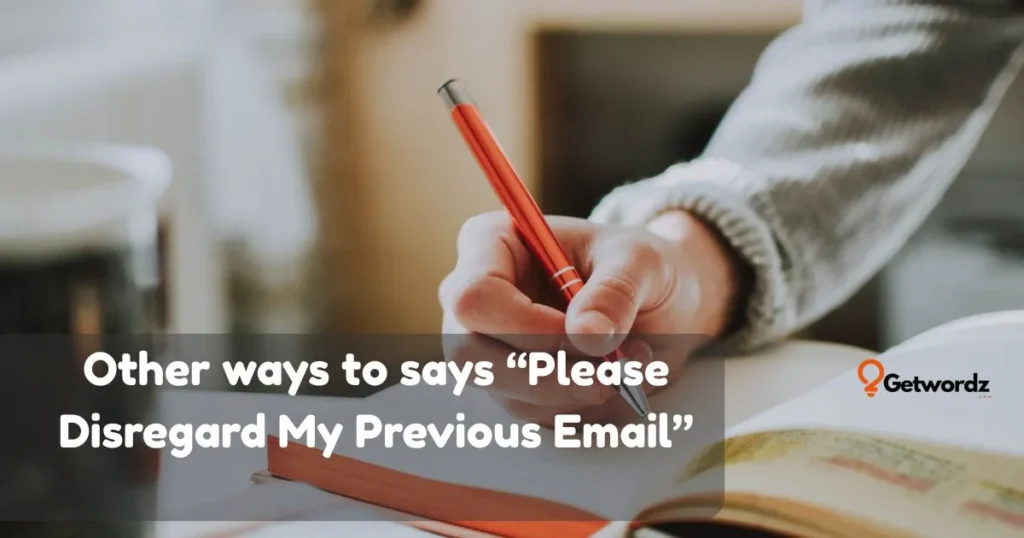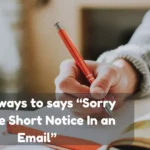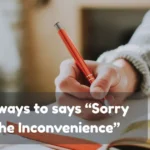Please Disregard My Previous Email is a polite and professional phrase used when you need to correct an error, retract information, or send an updated message after hitting “send” too soon.
We’ve all been there, sending an email only to realize a mistake seconds later. That awkward moment often leads to the familiar line, “Please disregard my previous email.” But while this phrase works, it can sound repetitive, overly formal, or even impersonal if used too often.
If you’re searching for better wording or creative alternatives to please disregard my previous email, you’re not alone. Whether you’re emailing a colleague, boss, client, or even a friend, how you handle a correction says a lot about your professionalism and tone.
Using fresh and thoughtful expressions can make your message sound more genuine, friendly, and confident, without losing clarity or respect.
In this post, you’ll find unique expressions, natural variations, and funny yet polite ways to say please disregard my previous email that fit perfectly for both professional and personal situations. Ready to discover the best alternatives that sound effortless and sincere? Let’s dive in.
1. Kindly Ignore My Previous Email
Scenario: You just realized you sent the wrong document to a client or shared outdated details about a meeting. To fix the confusion politely, you follow up with a message saying, “Kindly ignore my previous email.”
Explanation: This is a polite and professional way to correct an earlier message. It softens the tone of correction, making it sound respectful rather than abrupt. It’s one of the best creative alternatives to please disregard my previous email when writing in a formal tone.
Examples:
- “Kindly ignore my previous email, the correct file is attached here.”
- “Please kindly ignore my previous message; I’ve updated the details below.”
- “Kindly ignore my previous email regarding the meeting link, it has been changed.”
Why It Works: The word kindly adds warmth and respect, keeping your tone diplomatic and courteous. It’s ideal for professional communication when you want to maintain politeness while correcting an error.
2. Please Ignore My Last Email
Scenario: You hit send too soon and now need to retract or correct your message quickly. This phrase helps you do so without overexplaining.
Explanation: This is a simple and direct alternative to please disregard my previous email. It works in both casual and professional settings and feels a bit more natural and conversational.
Examples:
- “Please ignore my last email, I sent it before confirming the schedule.”
- “Oops! Please ignore my previous message. I’ll resend the correct version shortly.”
- “Please ignore my last email about the deadline; it’s been extended.”
Why It Works: Short, clear, and universally understood. This phrase gets straight to the point while sounding polite and efficient, perfect for fast-paced communication.
3. Disregard My Earlier Message
Scenario: You sent an email with a small mistake and don’t want to confuse the recipient with duplicate information.
Explanation: A formal and professional expression, disregarding my earlier message feels concise yet polite. It’s a better way to say please disregard my previous email when you need to maintain authority in tone.
Examples:
- “Disregard my earlier message about the event time, it has been updated.”
- “Please disregard my earlier message and refer to this one instead.”
- “Disregard my earlier note; the attached document is the correct version.”
Why It Works: It keeps the tone formal and businesslike while showing accountability. It’s a go-to phrase for corporate or client-facing emails.
4. Please Overlook My Previous Email
Scenario: You sent a message containing outdated or incomplete information and need to redirect attention to your latest update.
Explanation: Please overlook my previous email. It is a gentle and polite way to correct yourself. It feels less strict than disregard and adds a softer, more human touch.
Examples:
- “Please overlook my previous email; the new details are included below.”
- “Overlook my earlier message, and kindly check this updated version.”
- “Please overlook my previous email regarding the invoice number.”
Why It Works: The word overlook makes the correction sound more empathetic and less rigid, maintaining warmth in communication.
5. My Apologies for the Previous Email
Scenario: You realize your last email had a typo, wrong tone, or incorrect attachment and want to apologize while correcting it.
Explanation: This phrase focuses on taking responsibility before giving a correction. It’s both professional and sincere, making it one of the best unique expressions for error follow-ups.
Examples:
- “My apologies for the previous email; I’ve attached the correct file now.”
- “My apologies for the earlier message, it contained outdated data.”
- “My apologies for the confusion in my previous email.”
Why It Works: It blends apology with professionalism, showing humility and responsibility, traits that help maintain trust in workplace communication.
6. Please Disregard the Email Sent Earlier
Scenario: You mistakenly sent an email meant for someone else or with wrong info. This phrase helps you clarify things quickly.
Explanation: This is a classic formal phrase that feels slightly more structured than please disregard my previous email. It’s ideal for official corrections and company-wide communications.
Examples:
- “Please disregard the email sent earlier about the new policy update.”
- “Please disregard the email I sent this morning; a revised version follows.”
- “Please disregard the email sent earlier, details have changed.”
Why It Works: It’s clean, professional, and precise. The phrase removes ambiguity and fits well in all formal or business-related email contexts.
7. Ignore My Last Message, Please
Scenario: You’re messaging a coworker or friend and realize your previous note was unnecessary or premature.
Explanation: This phrase is friendly and conversational, making it suitable for semi-casual or internal communication. It reverses the usual structure for a natural, relaxed tone.
Examples:
- “Ignore my last message, please, I just got the update.”
- “Ignore my last text, please; turns out I was mistaken.”
- “Hey, ignore my last message, please, I figured it out!”
Why It Works: The reversed phrasing adds a touch of natural speech rhythm, making it sound less robotic and more human.
8. Forget What I Sent Earlier
Scenario: You accidentally sent a message that’s no longer relevant or contains wrong info.
Explanation: A casual and direct way to retract a previous message, this phrase works best in friendly or informal exchanges rather than professional emails.
Examples:
- “Forget what I sent earlier; I’ve already fixed the issue.”
- “Forget my earlier email, it’s no longer accurate.”
- “Forget what I sent before; here’s the correct file.”
Why It Works: It’s short, real, and conversational, perfect for relaxed settings where professionalism can take a back seat to speed and clarity.
9. Oops, Ignore That Last Email
Scenario: You made a lighthearted mistake in a friendly or internal message and want to correct it casually.
Explanation: This phrase adds a touch of humor and humility, making it great for team chats or informal correspondence. It’s a funny yet polite alternative to please disregard my previous email.
Examples:
- “Oops, ignore that last email, I attached the wrong file!”
- “Oops, ignore that last message; I got ahead of myself.”
- “Oops! Ignore that email, I sent it to the wrong thread.”
Why It Works: It’s warm, self-aware, and easygoing. The “oops” makes the correction feel human rather than stiff or overly formal.
Read more: 30 Other Ways to Say “As You Can See” With Examples!
10. That Last Email Was Sent by Mistake
Scenario: You accidentally hit “send” before reviewing your draft and now need to clarify what happened.
Explanation: This is a transparent and explanatory alternative to please disregard my previous email. It’s direct but still professional and can be used with clients, managers, or team members.
Examples:
- “That last email was sent by mistake; please refer to this one instead.”
- “Apologies, that last email was sent by mistake. Please see the updated info below.”
- “That last message was sent in error, please ignore it.”
Why It Works: Honesty always builds trust. This phrase shows responsibility while clearly guiding the reader to the right message.
11. Please Ignore My Earlier Email
Scenario: You’ve sent an earlier message with incomplete data and now have the correct version ready to go.
Explanation: This phrase is a clear and professional alternative to please disregard my previous email. It sounds polished without being overly formal, making it great for both business and personal use.
Examples:
- “Please ignore my earlier email and refer to the updated document below.”
- “Please ignore my earlier message about the event time; it has been changed.”
- “Please ignore my earlier email, I realized there was a typo in the subject.”
Why It Works: It’s respectful, clear, and easy to understand. This phrase maintains professionalism while making the correction smooth and natural.
12. Please Ignore the Message I Just Sent
Scenario: You clicked send too soon or forgot to attach a file, and now you need to let the recipient know immediately.
Explanation: This phrase is a direct and time-sensitive alternative to please disregard my previous email. It works perfectly for real-time corrections in a busy email environment.
Examples:
- “Please ignore the message I just sent; I’ll resend with the correct attachment.”
- “Please ignore the message I just sent, it went out prematurely.”
- “Please ignore the message I just sent; here’s the updated version.”
Why It Works: The immediacy of “just sent” adds context, helping recipients understand that you’ve already corrected the issue.
13. That Email Wasn’t Meant for You
Scenario: You mistakenly send an internal note to the wrong person or group.
Explanation: This is a casual yet honest way to acknowledge a misdirected message. It’s better for semi-formal or friendly communication where transparency matters more than strict professionalism.
Examples:
- “Sorry, that email wasn’t meant for you, it was for the HR team.”
- “That email wasn’t meant for you, please ignore it.”
- “Oops, that message wasn’t intended for your inbox.”
Why It Works: It’s direct, relatable, and human, great for preventing confusion when emails end up in unintended hands.
14. Disregard That Message
Scenario: You’ve sent a short update or request that is no longer valid.
Explanation: This phrase is brief and formal, making it ideal for quick, to-the-point corrections. It’s a cleaner variation of please disregard my previous email that saves space while keeping authority.
Examples:
- “Disregard that message; I’ve already handled the issue.”
- “Disregard that message and refer to the new details below.”
- “Please disregard that message,it contains outdated information.”
Why It Works: It’s professional and efficient, signaling you’re in control and quick to correct mistakes.
15. Please Ignore the Earlier Communication
Scenario: You sent a newsletter or mass email with an error and need to notify everyone about the correction.
Explanation: This phrase is formal and polished, making it perfect for company-wide or client-facing updates. It sounds more corporate than casual.
Examples:
- “Please ignore the earlier communication regarding the price adjustment.”
- “Please ignore the earlier communication; it contained a formatting error.”
- “Please ignore the earlier communication and refer to this corrected version.”
Why It Works: The word communication gives it a professional tone suitable for business contexts and large-scale announcements.
Read more: 30 Other Ways To Say “Happy To See You” With Examples!
16. My Earlier Email Contained an Error
Scenario: You’ve found a factual or technical mistake in your last email and want to correct it clearly.
Explanation: This is a transparent and responsible phrase, ideal for when accuracy matters. It shows accountability and professionalism.
Examples:
- “My earlier email contained an error in the time slot, please note the updated schedule.”
- “My earlier email had a typo in the subject line; here’s the correct one.”
- “My earlier email contained an error regarding the client name; please disregard it.”
Why It Works: It’s respectful and fact-focused, showing you value accuracy over appearances.
17. Please Consider My Latest Email Instead
Scenario: You’ve sent an update with the most recent and correct information and want readers to focus on that version.
Explanation: This phrase is a gentle and diplomatic alternative to please disregard my previous email. It emphasizes what to do rather than what not to.
Examples:
- “Please consider my latest email instead, it has the final schedule.”
- “Please consider my latest email instead of the one I sent this morning.”
- “Please consider my latest email as the updated version.”
Why It Works: It’s solution-oriented and polite, guiding readers toward the correct information smoothly.
18. Disregard My Previous Note
Scenario: You sent a short internal message that’s now irrelevant or outdated.
Explanation: This is a compact and semi-formal phrase, perfect for office chats, project teams, or professional exchanges. It’s a lighter take on the standard expression.
Examples:
- “Disregard my previous note; the figures have changed.”
- “Disregard my previous note, new details are in the shared file.”
- “Disregard my previous note about the presentation order.”
Why It Works: It’s tidy and efficient, showing that you’re quick to make corrections while keeping communication brief.
19. Sorry, That Last Email Was Wrong
Scenario: You’ve realized your earlier message contained misinformation and want to correct it casually.
Explanation: This phrase adds a touch of apology and humility, making it sound more personal and less mechanical. It’s a great casual alternative for internal or friendly settings.
Examples:
- “Sorry, that last email was wrong, here’s the updated info.”
- “Sorry, that last message had a mistake about the meeting link.”
- “Sorry, that last email was wrong; please use this one instead.”
Why It Works: It feels genuine and kind. Adding “sorry” softens the correction and makes it feel more human.
20. Ignore the Message Before This One
Scenario: You sent two back-to-back messages and only the second one is accurate.
Explanation: A simple, conversational alternative that’s clear and friendly. It’s perfect for team chats, informal exchanges, or group projects.
Examples:
- “Ignore the message before this one; it had the wrong file.”
- “Ignore the message before this one; this update is final.”
- “Ignore the message before this one; I’ve already fixed the mistake.”
Why It Works: It’s conversational and natural, the kind of phrasing people use every day, perfect for quick corrections.
Read more: 30 Other Ways To Say “Peace of Mind” With Examples!
21. The Previous Email Contained Incorrect Information
Scenario: You’ve noticed a factual error or wrong attachment in your last message.
Explanation: This phrase sounds formal and detail-oriented, making it great for professional emails that require precision and accountability.
Examples:
- “The previous email contained incorrect information about the payment schedule.”
- “The previous email contained an error in the contact details.”
- “The previous email contained incorrect information; please see the correction below.”
Why It Works: It demonstrates accuracy, professionalism, and care for clear communication, key traits in formal correspondence.
22. Please Refer to My Updated Email
Scenario: You’ve sent a revised or corrected version of an earlier email and want recipients to focus on that.
Explanation: This is a solution-focused phrase that directs attention to the right message instead of the mistake. It’s polite and professional.
Examples:
- “Please refer to my updated email for the correct details.”
- “Please refer to my updated email regarding tomorrow’s meeting.”
- “Please refer to my updated email instead of the earlier version.”
Why It Works: It keeps things positive and proactive by redirecting the reader’s attention effectively.
23. That Message Went Out Too Soon
Scenario: You accidentally hit “send” before proofreading or finishing your thought.
Explanation: This casual and transparent phrase helps you admit a small mistake without sounding unprofessional.
Examples:
- “That message went out too soon, here’s the complete version.”
- “That email went out too soon; please ignore it.”
- “That message went out too soon, sorry about that!”
Why It Works: It’s relatable and kind, offering honesty in a way that’s easy for anyone to understand.
24. I Sent the Wrong Version Earlier
Scenario: You’ve attached or shared the wrong file or outdated content.
Explanation: This phrase combines clarity and accountability, making it suitable for professional or client communication.
Examples:
- “I sent the wrong version earlier; please find the correct one attached.”
- “I sent the wrong version earlier today, please use this document instead.”
- “I sent the wrong version earlier; my apologies for the confusion.”
Why It Works: It shows ownership and care for detail, strengthening trust and reliability.
25. Please Ignore the Draft I Just Sent
Scenario: You accidentally send an unfinished message or draft email.
Explanation: This is a direct and time-sensitive expression that tells the recipient not to take your earlier message seriously.
Examples:
- “Please ignore the draft I just sent; it wasn’t ready yet.”
- “Please ignore the draft I just sent, it went out by accident.”
- “Please ignore the draft I just sent; I’ll send the final version shortly.”
Why It Works: It’s straightforward, respectful, and perfect for quick follow-ups when you’re fixing small communication errors.
Read more; 30 Other Ways To Say “Please Find Attached” Examples!
26. I Realized My Earlier Email Was Incorrect
Scenario: You sent information that turned out to be wrong and want to clarify politely.
Explanation: This phrase sounds professional and thoughtful, showing you take accuracy seriously.
Examples:
- “I realized my earlier email was incorrect; please see the corrected version below.”
- “I realized my earlier message was incorrect; here’s the update.”
- “I realized my earlier email contained an error, so please disregard it.”
Why It Works: It’s reflective, responsible, and shows honesty, perfect for maintaining professionalism and trust.
27. The Previous Message Is No Longer Relevant
Scenario: You sent an email that’s outdated due to changes or updates.
Explanation: This is a neutral and formal phrase that communicates the change without sounding apologetic.
Examples:
- “The previous message is no longer relevant; please refer to this one.”
- “The previous message is no longer relevant due to updated timelines.”
- “The previous message is no longer relevant; kindly note the changes.”
Why It Works: It focuses on clarity, helping the reader know which information to prioritize.
28. Please Ignore the Previous Notification
Scenario: You sent an automated or system-generated email with incorrect data.
Explanation: This phrase works best for official or technical communication, especially in customer service or IT contexts.
Examples:
- “Please ignore the previous notification; it was sent in error.”
- “Please ignore the previous notification; an updated one will follow.”
- “Please ignore the previous notification; the correct data is now available.”
Why It Works: It’s professional, calm, and perfectly suited for large-scale or automated messaging corrections.
29. Please Accept My Apologies for the Confusion
Scenario: You caused unintentional confusion with your earlier message.
Explanation: This polite phrase combines an apology with clarity. It’s more emotional and empathetic, showing care for how your words were received.
Examples:
- “Please accept my apologies for the confusion caused by my earlier email.”
- “Please accept my apologies for the confusion, here’s the correct update.”
- “Please accept my apologies for the confusion; disregard my previous message.”
Why It Works: It humanizes your communication, building trust and goodwill while fixing the issue.
30. Please Ignore My Earlier Message and See This One Instead
Scenario: You need to clearly direct attention away from the previous message to the correct one.
Explanation: This phrase blends clarity, politeness, and precision, making it perfect for formal or semi-formal corrections.
Examples:
- “Please ignore my earlier message and see this one instead.”
- “Please ignore my earlier message and refer to this email for updated info.”
- “Please ignore my earlier message and use this as the correct reference.”
Why It Works: It’s straightforward, polite, and easy to follow, ideal for ensuring your readers focus on the right content without confusion.
✅ Pros and cons of Using “Please Disregard My Previous Email”
pros
- Professional and Polite: It sounds formal and respectful, making it suitable for business or client communication.
- Clear and Direct: The phrase leaves no room for misunderstanding—readers instantly know to ignore the earlier message.
- Universally Recognized: It’s a common expression, so people across industries easily understand its meaning.
- Shows Accountability: Using it demonstrates responsibility and awareness of your mistake, which builds trust.
- Quick Damage Control: It allows you to correct errors or retract wrong information without overexplaining.
⚠️ Cons
- Sounds Overused: It’s very common, so it can feel repetitive or robotic when used frequently.
- Too Formal for Casual Settings: It may come off as stiff or cold in friendly or team conversations.
- Lacks Personal Touch: The phrase doesn’t express empathy or warmth, which can make it feel impersonal.
- May Trigger Confusion: If not followed by a clear correction, recipients might not know what to ignore.
- Not Ideal for Humor or Informal Chats: It doesn’t fit well in relaxed, lighthearted, or internal communication tones.
Closing words
Please Disregard My Previous Email might be a simple phrase, but learning better ways to express it can make your communication sound more natural and thoughtful.
This post shared creative alternatives and unique expressions to help you avoid repetitive or overly formal wording while staying polite and clear.
Whether you’re emailing a colleague, updating a client, or messaging a friend, these fresh ways to say it fit every situation. Try one of these creative alternatives in your next message to sound confident and professional without sounding stiff.
Using different wording not only refines your tone but also shows sincerity and emotional awareness. So next time you need to correct yourself gracefully, use one of these thoughtful variations instead of simply saying please disregard my previous email.




